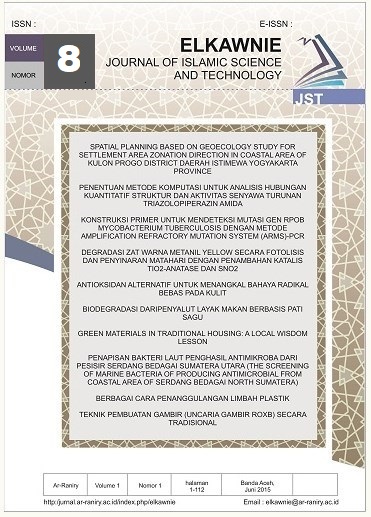Synthesis of Reduced Graphene Oxide and Zinc Oxide Composite From Candlenut Shell Charcoal (Aleuritas moluccana)
DOI:
https://doi.org/10.22373/ekw.v8i1.9405Keywords:
Graphene oxide, Capacitance, Composite, Candlenut shellAbstract
Abstract: Candlenut shell is one of the by-products of the hazelnut processing industry which has not been widely utilized. However, the carbon content from the candlenut shell can be used as charcoal, which has the potential as the base material for making reduced graphene oxide (GO) capacitance products. After the composite process, characterization of the rGO and its composites was carried out with FTIR and XRD instruments. The synthesis results obtained are combined with ZnO to determine the value of the electrical result. From FTIR characterization, it was found that C=C, C-O, and O-H functional groups were formed, and the XRD measurement resulted in a peak diffractogram at 2θ ⁓ 23,96°, which is typical for rGO material. The result of testing with a conductivity meter at a rGO-ZnO 0:1 ratio, produced a capacitance value of 4,72 mF, in terms of 1:2, 6,34 mF; 1:1, 7,36 mF; 2:1, 5,18 mF; and 1:0, 4,28 mF. The optimum ratio of rGO-ZnO with the highest capacitance value was found, which is the ratio of 1:1 with a capacitance value of 7,36 mF.
Abstrak: Tempurung kemiri merupakan salah satu hasil samping dari industri pengolahan kemiri yang masih belum banyak dimanfaatkan secara luas. Akan tetapi kandungan karbon pada tempurung kemiri dapat dijadikan arang yang berpotensi sebagai salah satu bahan dasar pembuatan Grafena Oksida(GO) tereduksi. Hasil sintesis yang didapatkan dikompositkan dengan ZnO untuk mengetahui nilai kapasitansi yang dihasilkan. Setelah proses komposit, dilakukan karakterisasi terhadap rGO dan kompositnya dengan instrumen FTIR dan XRD kemudian diuji nilai kapasitansi elektrik yang dihasilkan dengan alat multimeter. Berdasarkan hasil karakterisasi FTIR, didapati terbentuk gugus C=C, C-O, O-H dan uji XRD menghasilkan nilai 2θ ⁓ 23,96o yang mengindikasikan rGO .Hasil pengujian dengan konduktimeter menghasilkan data perbandingan rGO-ZnO 0:1 menghasilkan nilai kapasitansi 4,72 mF, 1:2, 6,34 mF; 1:1, 7,36 mF; 2:1, 5,18 mF; dan 1:0, 4,28 mF. Diperoleh perbandingan optimum rGO-ZnO dengan nilai kapasitansi paling besar yaitu perbandingan 1:1 sebesar 7,36 mF.
References
Alam, S. N., Sharma, N., & Kumar, L. (2017). Synthesis of Graphene Oxide (GO) by Modified Hummers Method and Its Thermal Reduction to Obtain Reduced Graphene Oxide (rGO). Scientific Research, 6, 1–18. https://doi.org/10.4236/graphene.2017.61001.
B. Wei, H. Liang, D. Zhang, Z. Qi, H. Shen, and Z. Wang (2018). Magnetron sputtered TiN thin films toward enhanced performance supercapacitor electrodes. Mater. Renew. Sustain. Energy pp. 1–9. (https://doi.org/10.1007/s40243-018-0117-9
Fitrilawati, Vika Marcelina, Diyan Unmu Dzujah, Ayi Bahtiar,Yeni Wahyuni Hartati, Norman Syakir. (2019). Energy Storage Characteristics of Electrochemically Deposited Graphene Oxide on ITO and Cu Substrates. Materials Science Forum Vol. 966 pp 428-432. (https://doi.org/10.4028/www.scientific.net/MSF.966.428)
Gerasimov, G. (2017). Graphene-Based Gas Sensors. In C. M. Hussain & B. Kharisov (Eds.), Advanced Environmental Analysis: Applications of Nanomaterials,2(pp.133152).https://doi.org/10.1039/9781782629139
Harahap, S. A. P. (2018). Sintesis Grafena dari Oksidasi Grafit dan Reduksi Oksida Grafit Menggunakan Reduktor Asam Sitrat. Universitas Sumatra Utara.( http://repositori.usu.ac.id/handle/123456789/2608
Hidayat, A., Setiadji, S., & Hadisantoso, E. P. (2018). Sintesis Oksida Grafena Tereduksi (rGO) dari Arang Tempurung Kelapa (Cocos nucifera). Al-Kimiya, 5(2), 68–73. https://doi.org/https://doi.org/10.15575/ak.v5i2.3810.
Husnah, M., Fakhri, H. A., E., N. E., Aimon, A. H., & Ferry Iskandar. (2015). Pengembangan Metode Sederhana pada Sintesis Reduced Graphene Oxide (rGO) dan Pengaruhnya Terhadap Konduktivitas Listrik yang Dihasilkan. PROSIDINGSKF,252256.https://ifory.id/proceedings/2015/X9H3ae2VT/skf_2015.
Lasmana, D., Pranata, G., Nurlina, R., Aprilia, A., Syakir, N., & Fitrilawati. (2016). Karakteristik Transparansi Film Tipis Oksida Grafena Tereduksi (R-GO) Untuk Elektroda Transparan. Material Dan Energi Indonesia, 06(01), 15–19. https://doi.org/10.24198/jmei.v6i01.11144.g5006
Lee Jin Ling, Chin Seik Yee, and Mariatti Jaafar ( 2017 ). Effect of sonication time on the properties of multilayer graphene. AIP Conference Proceedings, Volum 1865, Issue 110.1063/1.4993323 https://doi.org/10.1063/1.4993323.
Li, C., Zhuang, Z., Jin, X., & Chen, Z. (2017). A facile and green preparation of reduced graphene oxide using Eucalyptus leaf extract. Applied Surface Science, 422, 469–474. https://doi.org/10.1016/j.apsusc.2017.06.032.
Liyanage, C. D., & Pieris, M. (2015). A Physico-Chemical Analysis of Coconut Shell Powder. Procedia Chemistry, 16, 222–228. https://doi.org/10.1016/j.proche.2015.12.045.
Marcelina, V., Yuliasari, F., Hartati, Y. W., Fitrilawati, & Syakir, N. (2017). Pembuatan Lapisan Tipis Oksida Grafena Tereduksi sebagai Material Elektroda Sistem Kapasitor dan Karakterisasinya. Fisika Dan Aplikasinya, 13(3), 112–114. https://doi.org/10.12962/j24604682.v13i3.2841.
Mas’udah, K. W., Nugraha, I. M. A., Abidin, S., Ali, Mufid, Astuti, F., & Darminto. (2016). Solution of Reduced Graphene Oxide Synthesized from Coconut Shells and Its Optical Properties. AIP Conference Proceedings. https://doi.org/10.1063/1.4945499.
M. Husnah, H. A. Fakhri, F. Rohman, A. H. Aimon, and F. Iskandar ( 2017) “A modified Marcano method for improving electrical properties of reduced graphene oxide (rGO),” Mater. Res. Express, vol. 4, no. 6, 2017, doi: 10.1088/2053-1591/aa707f.
M. S. Khan, R. Yadav, R. Vyas, A. Sharma, M. K. Banerjee, and K. Sachdev (2020) “Synthesis and evaluation of reduced graphene oxide for supercapacitor application,” Mater. Today Proc., vol. 30, no. xxxx, pp. 153–156 doi: 10.1016/j.matpr.2020.05.403.
Nugraheni, A. Y., Nasrullah, M., Prasetya, F. A., Astuti, F., & Darminto. (2015). Study on Phase, Molecular Bonding, and Bandgap of Reduced Graphene Oxide Prepared by Heating Coconut Shell. Materials Science Forum 827, 827, 285–289. https://doi.org/10.4028
Prasetya, F. A., Nasrullah, M., Nugraheni, A. Y., & Darminto. (2015). Study of Raman spectroscopy on graphene phase from heat treatment of coconut (Cocus Nucifera) shell. Materials Science Forum, 827, 290–293. https://doi.org/10.4028/www.scientific.net/MSF.827.290
Puspitasari, W. R. (2017). Preparasi dan Sintesis Graphene Oxide dengan Variasi Waktu Pembakaran Kain Perca Menggunakan Metode Penangkapan Asap dengan Kaca Preparat Berdasarkan Uji Absorbansi dan Gugus-gugus Fungsional. Universitas Negeri Yogyakarta.
Setiadji, S., Nuryadin, B. W., Ramadhan, H., Sundari, C. D. D., Sudiarti, T., Supriadin, A., & Ivansyah, A. L. (2018). Preparation of reduced Graphene Oxide (rGO) assisted by microwave irradiation and hydrothermal for reduction methods. IOP Conf. Series: Materials Science and Engineering, 1–8. https://doi.org/10.1088/1757-899X/434/1/012079
Tang, L.-C., Zhao, L., & Guan, L.-Z. (2017). Graphene/Polymer Composite Materials: Processing, Properties and Applications. In Advanced Composite Materials: Properties and Applications (pp. 349–491). https://doi.org/10.1515/9783110574432-007
Tiwari, S.K., Sahoo, S., Wang, N., Huczko, A. 2020. Graphene Research and their Outputs: Status and Prospect. Journal of Science: Advanced Materials and Devices, 5, 10-29.
Vinanza, N. E. (2018). Sintesis dan Karakterisasi Grafena Berbasis Arang Tempurung Kelapa [Universitas Sultan Ageng Tirtayasa]. https://repository.untirta.ac.id/
Zheng, S., Wu, Z.-S., Wang, S., Xiao, H., Zhou, F., Sun, C., Bao, X., & Hui-Ming Cheng. (2017). Graphene-based materials for high-voltage and high-energy asymmetric supercapacitors. Energy Storage Materials, 6, 70–79. https://doi.org/10.1016/j.ensm.2016.10.003
Downloads
Additional Files
Published
Issue
Section
License
Proposed Policy for Journals That Offer Open Access Authors who publish with the Elkawnie journal agree to the following terms:
a. Authors retain copyright and grant the journal right of first publication with the work simultaneously licensed under a Creative Commons Attribution License that allows others to share the work with an acknowledgement of the work's authorship and initial publication in this journal.
b. Authors are able to enter into separate, additional contractual arrangements for the non-exclusive distribution of the journal's published version of the work (e.g., post it to an institutional repository or publish it in a book), with an acknowledgement of its initial publication in this journal.
c. Authors are permitted and encouraged to post their work online (e.g., in institutional repositories or on their website) prior to and during the submission process, as it can lead to productive exchanges, as well as earlier and greater citation of published work (see The Effect of Open Access).

























